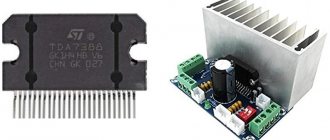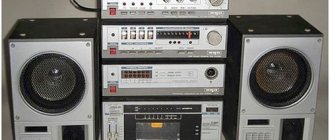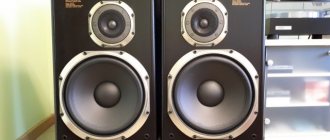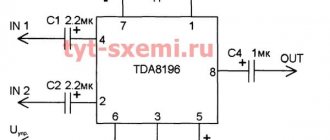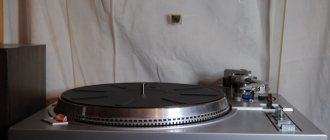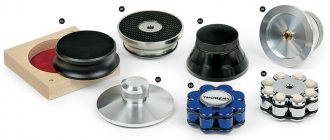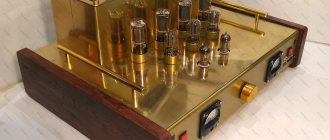In the world of vinyl sound it is very easy to get confused, especially for a beginner. Let’s say they gave you a vinyl record, and you liked this gift so much that you wanted to immediately collect your vinyl collection, come home in the evenings and enjoy the warm tube sound - so for this it is important to choose a good player so as not to be disappointed and not waste money a second time already on a really good device.
To make it easier for you, I have put together a selection of three vinyl players from the famous Lenco brand, which has been creating speaker systems and vinyl players since the early 60s.
Nowadays, Lenco's headquarters are located in the Netherlands, and the production process has been transferred to China. However, vinyl players are still created under the supervision of Swiss engineers, and only high-quality wood and other materials are used in production.
Below I want to show you three options for turnkey audio systems for listening to vinyl. That is, the player itself also comes with speakers, so you don’t need to buy anything in addition, you just need to unpack Lenco LS-100 for 14,990 rubles, Lenco LS-300 for 19,990 rubles, or Lenco LS-500 for 29,990 rubles out of the box, put it on the table, turn it on and enjoy.
Although, each model has its own nuances, and I’ll tell you about them too. Let's start with the most affordable option for an absolute beginner in the world of vinyl:
Lenco LS-100 Entry Level Vinyl Audio System
This vinyl audio system can be described in two words: great sound.
In addition to the sound, you will also enjoy the classic design of both the player itself and the included speakers. Despite its visual simplicity, the Lenco LS-100 has all the basic features of a mid-price turntable, such as:
✷ Bluetooth connection support ✷ Three rotation speeds – 33, 45, 78 rpm ✷ Belt drive ✷ Wooden body ✷ Removable protective cover ✷ RCA output for connecting external speakers
Built-in Bluetooth allows you to connect a smartphone to the player and use the system's speakers to listen to music from the gadget. The Lenco LS-100 also has an automatic stop function, where the record stops rotating automatically as soon as the needle reaches the end of the last groove.
This minimizes the risk of scratches, ensuring long life for both the included stylus and your records.
The power of the speakers is 10 W each. This way you can fill any room with warm tube sound.
price – 14,990 rubles.
Vinyl audio system Lenco LS-300 for those who want louder
This vinyl audio system model has several significant differences from the previous Lenco LS-100. Firstly, the power of the supplied speakers is 2 times higher - 20 W each, and secondly, the kit already includes a proprietary Audio Technica magnetic cartridge.
In addition, the speakers are connected to the player using speaker cables, but there are also RCA connectors for connecting additional external speakers, if you have them.
Among other features, the Lenco LS-300 has:
✷ Bluetooth connection support ✷ Two rotation speeds – 33 and 45 rpm ✷ Belt drive ✷ Auto-stop function ✷ Wooden body ✷ Removable protective cover
To create a stereo effect, it is recommended to place the supplied speakers further away from each other to get the clearest sound without interference.
You can connect your smartphone via Bluetooth, so that music from the gadget will be played through Lenco speakers. There is an auto-stop function, and the dustproof cover will keep the “spinner” from dust.
price – 19,990 rubles.
How to choose the best player
Drive unit
At the moment, there are two main types of drive: belt (pass) and direct.
Direct Drive means that the motor is located under the platter (the plate on which the record is placed) and is directly connected to it. This is a very reliable design that has many advantages, such as: quick start and stop of the disk (there will be no “mooing” during acceleration), high stability of operation (the speed does not fluctuate), and the absence of fragile elements. The disadvantages include a fairly high level of detonation, which means that a motor connected directly to the disc during operation can transmit some of the vibrations to the record, which will have a bad effect on the sound quality, so a well-implemented direct drive will be relatively expensive.
A belt drive means that the torque from the motor to the support disk is transmitted using a belt; this design also has its pros and cons. The main advantage is that at a low cost you can achieve impressively low detonation, because the motor does not transmit vibration to the disc. An important feature of a belt drive is its smooth operation; the disc spins and stops more slowly; it is believed that it treats the plates more gently, which means they will last longer. The downside is that the belt can wear out and stretch, which means it needs to be changed regularly. In addition, the stability of the rotation speed is also not its strong point.
Previously, there was a third type of drive - roller. But it is expensive and complicated, and the advantages are quite dubious; now it is difficult to find such a turntable. There are other types of drive, but they already belong to perversions loosely related to listening to music.
Cartridge
There are two main types of cartridge (head): MM and MC. They use the same principle of electromagnetic induction, but have some design differences. Honestly, a description of the design of the pickup is worthy of a separate article, because it is, in fact, the most important part in the player. Therefore, I propose to consider only the pros and cons of these designs.
MM (moving magnet) cartridges are the most popular, their initial price is low, they are more universal and omnivorous to the genres and quality of recorded music on a record, they forgive mistakes for beginners because they better withstand harsh use, in most heads you can replace the needle (it is still called "insertion"). You can change the needle due to wear or breakage, and for some cartridges you can buy an insert with a different type of sharpening (yes, yes, there is also room for engineering development here).
MC (moving coil) cartridges are the first sign of a disease called “audiophilia”. A joke, albeit with some truth. It is believed that these cartridges convey sound in more detail, are more sensitive to the quality of the media and, as a result, are more capricious and fragile. They tend to be more expensive than MM cartridges and require a different type of phono stage. You should not immediately buy such a cartridge; it does not forgive mistakes for inexperienced users.
There are several other types of cartridges such as MIMC, MMC, etc., but I guarantee you that you will know exactly when you are ready to hear about them.
Nowadays players with piezoelectric heads are still produced. Such devices are very cheap and popular, but, believe me, they do not deserve any attention, this is a very old and low-quality technology, used, for example, in primitive Soviet electrophones such as “Yunost 301”.
It is worth noting that the ability to select and replace a cartridge should be in every self-respecting player, although there are decent inexpensive turntables that do not offer this, for example, in younger models from Pro-Ject. This is simply a ready-made configuration that is as cheap as possible, which also sounds good, so there is no need to interfere with it.
Tonearm
The two most popular types are straight and S-shaped.
A straight tonearm is lighter, simpler, easy to configure and upgrade the cartridge, but has a so-called tracking angle error. This means that during playback, the position of the stylus relative to the record changes unevenly, which theoretically can cause slight sound distortion in the extreme positions of the tonearm, but in practice this is difficult to encounter. Even monstrously expensive turntables have straight tonearms; engineers are obviously not very worried about this problem. The S-shaped tonearm is designed in such a way that this error does not occur, however, it is heavier, so you should be a little more careful in choosing and setting up the cartridge if you change it.
Of course, we are talking about average models. In fact, there are heavy straight tonearms, and light S-shaped ones, and what not.
There are also, for example, tangential tonearms, but these are very complex, rare and expensive devices; I won’t describe them, because you won’t find them in stores anyway.
A sign of a good player is the presence of anti-skating. There is such a thing as “skating” - this is a force that, in accordance with certain laws of physics, pulls the turntable needle towards the axis of rotation, because of this it can come into contact with the record at the wrong angle and this will negatively affect the sound. Anti-skating is designed to compensate for this force. In general, at the very beginning of your music lover’s journey, this function can be neglected.
Automation
We divide them into three main types: automatic, semi-automatic and manual (almost like washing machines).
Automatic means that you just press a button, then the tonearm itself moves towards the record, lowers the needle, and at the end of playback it returns to its place.
Semi-automatic is, as a rule, only automatic return of the tonearm, and its feeding is carried out manually.
Manual control means that you have to do everything yourself.
There is no better option here. The presence of any automation complicates the design of the turntable, therefore, it will either cost more or work poorly. Whether you are ready to overpay for this or spoil the records is up to you. Manual control requires a certain accuracy; there is a risk of ruining something yourself.
But that's not all
As you can imagine, the player is just the tip of the iceberg. In order to listen to music on records, you will need several more devices, without which it will be of absolutely no use. In fact, the chain will look like this: turntable - phono stage - amplifier - speakers.
As we have already found out, vinyl is a rather specific musical medium. One of its features is that the sound is recorded with some defect. That's how it should be. Don't get into it. Just remember this fact. So, a phono stage is needed to restore it back. The quality of the sound also greatly depends on the quality of the phono stage. It can be in the form of a stand-alone device, it can be built into a speaker amplifier, or it can be built into a turntable. The built-in phono stage is a sign of an entry-level player; it doesn’t sound very good, but it’s good for the first time. And so that you don’t have to change the turntable when you get to a decent phono stage or integrated amplifier, make sure that it can be turned off. It’s strange, but for some reason not all models have this option.
Why do we still want to listen to records, despite all these difficulties?
It’s probably worth writing about this, because at some stage your enthusiasm may be dashed by harsh reality. There is a joke among music lovers: “There are two things that really attract me to vinyl: the high cost and the inconvenience.” There is indeed truth in this: equipment and records are not cheap, it is essentially a rather cumbersome and complex system, and the process of collecting and listening itself requires a certain level of involvement and the acquisition of some specific skills. But if you love music enough, all this will not be important to you, since it will open up a completely new facet of it. You probably noticed that the text deliberately does not say whether there is a difference in the sound of vinyl compared to other sound media, and what it is. In fact, this was done only because this issue is simply not questioned. Moreover, you will be surprised when you actually discover it.
What else will you notice when you start diving into the world of vinyl records? Firstly, you will suddenly discover that the disc itself, its design, cover, all kinds of tabs, posters, stickers, etc. - this is a continuation of the author’s creative plan, which will allow him to be discovered from a new side, this will be a certain new level of interaction between the performer and the listener. In addition, vinyl accustoms the listener to more thoughtful consumption of content; you will want to spend money exclusively on the music that you really love, and I simply cannot describe the delight of owning your favorite recording here.
It's no surprise that people still listen to music recorded decades ago; it truly was beautiful. However, you've probably noticed that when listening via streaming or in digitized form, old recordings sound rather poor compared to modern ones? As a rule, this sound has nothing in common with what you will hear when you turn on some old record on good equipment, most likely you will be amazed at how alive and powerful it will sound. And here, for me personally, another thrill begins: the opportunity to hear that very recording in the form in which people heard it then, and in which it was originally intended by the creators. Believe me, it's very interesting.
